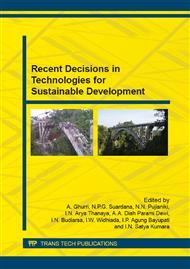p.355
p.361
p.371
p.377
p.384
p.390
p.396
p.403
p.413
The Influence of Distance Variation between Rings with Sloping Position on the Cylinder Surface to Drag Coefficient
Abstract:
There are so many equipment using cylinder in its application, such as bridge support column, smoke chimney, pole pillar of offshore oil drilling etc. When those kind of equipment is affected by air flow continuously, it would reducing the strength of those equipment construction. This strength reduction is caused by the drag force that is emerged due to the air flow and its direction are having the same direction with flow direction. So that it is necessary to do something to reduce the drag, one of it is by adding the rectangular ring at the cylinder surface. The rings is placed at the cylinder surface in 100 sloping position and then its ring distance would be varied. The aim of this research is to discover the influences of distance variation between the ring with sloping position on the cylinder surface to the drag coefficient. This research is conducted in the wind tunnel that consist of blower, pitot pipe, U manometer, inclined manometer, digital weight, cylinder, quadrangular rings (attached on the cylinder). The cylinder is placed in vertical position within the distance between the rings is varied as L/D = 0.5, 0.67, 0.83, 1.00, and 1.17. The Reynold number based on silinder diameter D = 60 mm is Re = 3.64 X 104 . Pressure distribution is determined by measuring cylinder surface pressure at 36 points with 100 interval. The result of this research showed that the lowest drag coefficient value occurs at the distance between the ring of L/D = 0.5 is 0.485. The large decreasing of the drag coefficient compare to without rings is 43.5%.
Info:
Periodical:
Pages:
384-389
Citation:
Online since:
July 2015
Authors:
Price:
Сopyright:
© 2015 Trans Tech Publications Ltd. All Rights Reserved
Share:
Citation:


